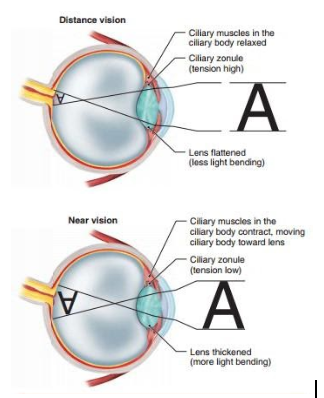
Which part of the human eye controls the focus of the eye by varying its thickness?
A.Ciliary muscles
B.Iris
C.Pupil
D.Retina
Answer
477.6k+ views
Hint: Focus of the eye is because of the lens that captures the light. But this focus is created by adjusting its thickness with the help of muscles.
Complete step by step answer:
-Human eye is one of the complicated sense organs of the body.
-The human eye contains a convex lens that focuses all the incoming light rays from the object, through cornea, by refracting them and forming a real, inverted image on the retina.
-Lens thickness is responsible for the focus of the eye. This change of thickness or shape of the lens is governed by the ciliary muscles.
-Ciliary muscles help in focusing the vision of the eye. This adjustment of the eye is called accommodation of the eye.
-Power of accommodation is the changing of the focal length of the lens to focus near or distant objects.
- To focus the near objects, ciliary muscles contracts cause thickening of the lens and to focus distant objects, ciliary muscles relax and cause thinning of the lens.

Figure: focusing light rays on the retina by distant object and near object respectively.
Hence option A is correct.
Note:
The other parts,
Iris is a dark muscular tissue that determines the colour of the eye. It lies just behind the cornea.
The small opening of the iris is called a pupil. Its size is controlled by the iris which is also controlled by the ciliary muscles. Pupil controls the amount of light entering the eye.
Retina is the light sensitive screen on which image is formed. It helps to convert the formed image in the electrical impulse that is transmitted to the brain through optic nerves.
Hence, they are accessory parts but do not control the size of the lens.
Complete step by step answer:
-Human eye is one of the complicated sense organs of the body.
-The human eye contains a convex lens that focuses all the incoming light rays from the object, through cornea, by refracting them and forming a real, inverted image on the retina.
-Lens thickness is responsible for the focus of the eye. This change of thickness or shape of the lens is governed by the ciliary muscles.
-Ciliary muscles help in focusing the vision of the eye. This adjustment of the eye is called accommodation of the eye.
-Power of accommodation is the changing of the focal length of the lens to focus near or distant objects.
- To focus the near objects, ciliary muscles contracts cause thickening of the lens and to focus distant objects, ciliary muscles relax and cause thinning of the lens.

Figure: focusing light rays on the retina by distant object and near object respectively.
Hence option A is correct.
Note:
The other parts,
Iris is a dark muscular tissue that determines the colour of the eye. It lies just behind the cornea.
The small opening of the iris is called a pupil. Its size is controlled by the iris which is also controlled by the ciliary muscles. Pupil controls the amount of light entering the eye.
Retina is the light sensitive screen on which image is formed. It helps to convert the formed image in the electrical impulse that is transmitted to the brain through optic nerves.
Hence, they are accessory parts but do not control the size of the lens.
Recently Updated Pages
Glucose when reduced with HI and red Phosphorus gives class 11 chemistry CBSE

The highest possible oxidation states of Uranium and class 11 chemistry CBSE

Find the value of x if the mode of the following data class 11 maths CBSE

Which of the following can be used in the Friedel Crafts class 11 chemistry CBSE

A sphere of mass 40 kg is attracted by a second sphere class 11 physics CBSE

Statement I Reactivity of aluminium decreases when class 11 chemistry CBSE

Trending doubts
10 examples of friction in our daily life

The correct order of melting point of 14th group elements class 11 chemistry CBSE

Difference Between Prokaryotic Cells and Eukaryotic Cells

One Metric ton is equal to kg A 10000 B 1000 C 100 class 11 physics CBSE

State and prove Bernoullis theorem class 11 physics CBSE

What organs are located on the left side of your body class 11 biology CBSE




